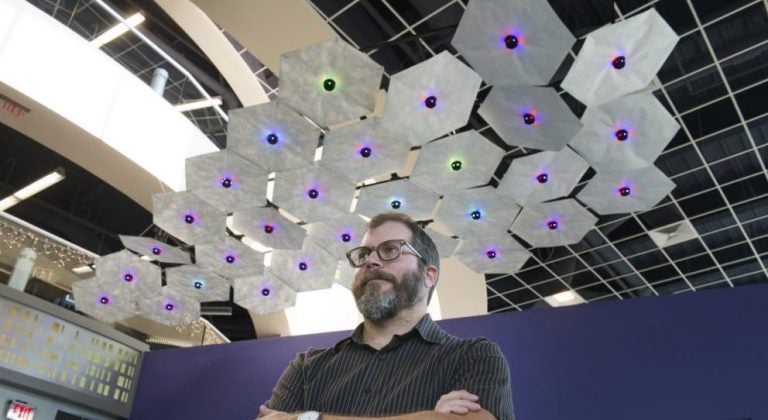Ryan Buyssens was the kind of kid who would take his toys apart and rebuild them in new ways. Sometimes they worked. Sometimes they didn’t.
He didn’t think he’d make a career out of his tinkering, but he has. Not only is he an assistant professor for sculpture and art at the University of Central Florida, but he’s also an artist whose work is being shown in places like San Francisco, Washington, D.C., Paris, London and Dubai. One of his latest exhibits is featured at the Orlando Science Center.
“I love discovery,” said the Michigan native. “I think that’s why I was so interested in science in school. But art, that journey toward discovery, that’s what I’m truly passionate about.”
That journey includes integrating technology into his toolbox, which also includes paint, brushes, clay and circuit boards. He also uses 3D printing to help build components of his work. It’s this blend of tech and art that led Buyssens to land a permanent exhibit at the Orlando Science Center. Digital fabrication is just another supplement to help us create, he said.
The piece, called Turbulence, is in the Orlando Science Center’s lobby. Just look up. Turbulence is an overhead kinetic installation that uses ultrasonic sensors to react to the presence of people below. Seemingly random and ever-changing, even without input, the colors of the LEDs as well as the angle of the oscillating panels are altered when people move below. The more change within the space, the greater the response of the piece.
“We have had a great response since incorporating more art into the museum,” said Brandan Lanman, Vice President of Visitor Experience. “Not only has Ryan’s project been successful at having a lasting positive impact on a guest’s memory as measured by the mouths agape and finger-pointing when visitors enter or leave, but this idea that art is an easy way to introduce many challenging scientific concepts has expanded into having guests creating content for our own Fusion: A STEAM Gallery – our new art gallery on level 3 of the science center.”
The Science Center, which recently renovated its entry and lobby area, was looking to show that science can be in anything.
Buyssens was inspired to complete the work by the motion of bird wings and how they move when they take flight. He was also inspired by the movement of water. Buyssens said he gets his inspiration from everything. From walking to lunch with colleagues to teaching students, everything has the potential to show up in one of his works of art.
He sees no conflict in integrating technology into his work. When he was almost ready to finish college, he dropped out because his art program had no computers at the time. So he took off a year to build himself a computer. He then bought a video camera and went about creating a multi-media art portfolio, which got him into graduate school. Off course, he had to go back and finish his undergraduate degree before his graduate school would give him the advanced degree.
But that’s Buyssens’ MO. He likes to figure out ways to express his vision, and if that means learning to build a computer or learning some computer coding, so be it. That ability to MacGyver a solution is one reason his workshop looks like more like a machine shop than an artist’s studio.
He’s produced an array of work that makes people wonder, “How did he come up with that?”
One of his earliest works is called Promenade. It showcases dozens of stick men made of matchsticks lined up on a metal circle atop a metallic contraption. Step on a pedal and the men begin running as the circle spins.
“I had to teach myself how to build that,” he said. “I even applied for a patent of the mechanics.”
Another piece called Resistance reproduces the complex articulated movement of a bird’s wings. It consists of wall-mounted, mechanical wings connected to proximity sensors that, when approached, gracefully flap as though trying to fly from their perches on the wall. The piece is full of contradictions. For example, wings are typically symbols of freedom and lightness but these are secured to the wall, unable to take flight — a fact referenced by the title of the piece.
And this month Buyssens is showcasing some of his newer work in the Faculty Exhibition 2016 at the Art Gallery in the Visual Arts Building. The show closes Dec. 9. Several of his works use sensitive paint. The images change depending on the viewer’s physical point of view.
“It’s fun,” he said. “That’s one thing I try to instill in my students. Use all your tools to create, to express and to have fun.”
